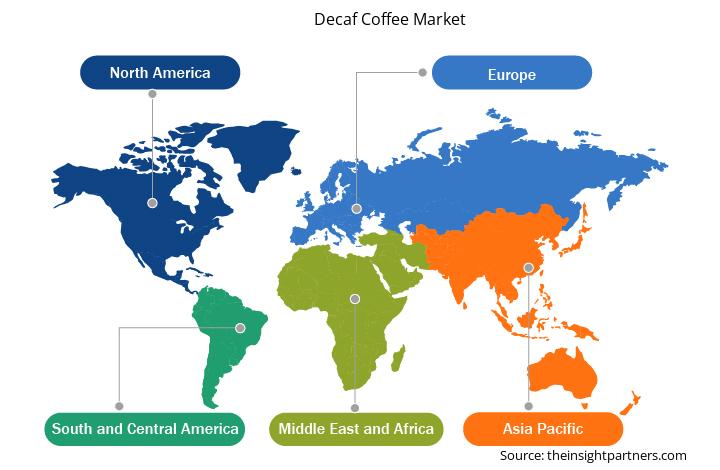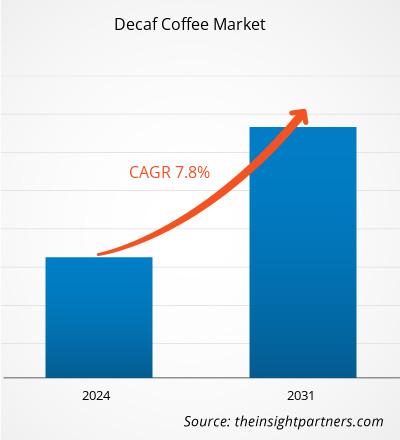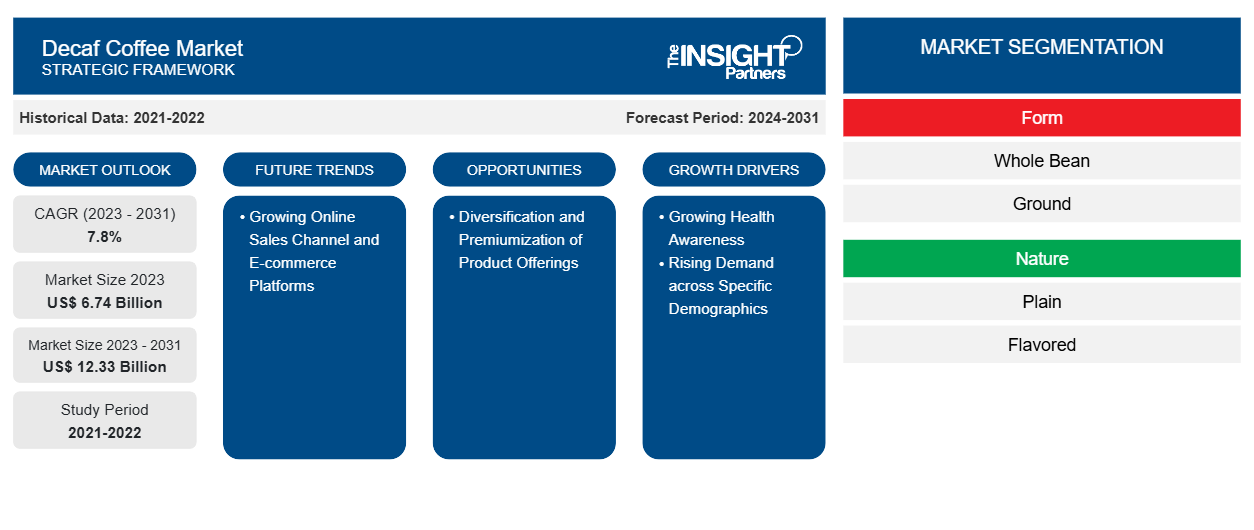Le marché du café décaféiné devrait atteindre 12,33 milliards USD d'ici 2031, contre 6,74 milliards USD en 2023. Le marché devrait enregistrer un TCAC de 7,8 % au cours de la période 2023-2031. La diversification et la premiumisation de l'offre de produits devraient apporter de nouvelles tendances sur le marché au cours de la période de prévision.
Analyse du marché du café décaféiné
L’attention accrue portée à la santé et au bien-être et l’intérêt croissant des jeunes adultes pour les boissons saines stimulent la demande de café décaféiné. Les femmes enceintes constituent un groupe de consommateurs important sur le marché du café décaféiné. De plus, le marché du café décaféiné offre une opportunité intéressante aux futures mères d’éviter les risques liés à la caféine tels que les fausses couches et l’insuffisance pondérale à la naissance. Le café décaféiné offre une solution qui permet à cette population de continuer à profiter de sa routine de café sans effets secondaires indésirables. La consommation croissante de café décaféiné chez certains groupes démographiques et la sensibilisation croissante à la santé devraient favoriser la croissance du marché du café décaféiné.
Aperçu du marché du café décaféiné
Le café décaféiné est fabriqué à partir de grains de café ordinaires qui subissent un processus d'élimination de la caféine. Ce processus consiste à faire tremper les grains de café verts dans un solvant pour en extraire la caféine. Les grains de café sont ensuite rincés et séchés pour éliminer tout résidu de solvant et de caféine. L'attention croissante portée par les consommateurs à la santé et au bien-être stimule la demande de café décaféiné, qui est perçu comme une alternative plus saine au café ordinaire. Les innovations croissantes en matière de saveurs de café décaféiné, telles que les lattes aromatisés et les infusions à froid, attirent de nombreux consommateurs, ce qui stimule la croissance de son marché. En outre, l'augmentation du revenu disponible et la demande de produits haut de gamme alimentent la demande pour le marché mondial du café décaféiné.
Personnalisez ce rapport en fonction de vos besoins
Vous bénéficierez d'une personnalisation gratuite de n'importe quel rapport, y compris de certaines parties de ce rapport, d'une analyse au niveau des pays, d'un pack de données Excel, ainsi que de superbes offres et réductions pour les start-ups et les universités.
- Obtenez les principales tendances clés du marché de ce rapport.Cet échantillon GRATUIT comprendra une analyse de données, allant des tendances du marché aux estimations et prévisions.
Moteurs et opportunités du marché du café décaféiné
Sensibilisation croissante à la santé
Un nombre croissant de consommateurs ressentent des effets secondaires tels que l’anxiété, l’insomnie et des problèmes digestifs en raison de la consommation de caféine. Une surdose de café provoque plusieurs effets sur la santé, tels que des tremblements, des nausées , des vomissements, des douleurs abdominales, une respiration rapide, un rythme cardiaque irrégulier, des crises de panique et des convulsions. Au cours des dernières années, les principaux acteurs du marché ont relevé ce défi en lançant des variétés de café décaféiné. Le café décaféiné offre la saveur et l’expérience du café ordinaire avec une teneur en caféine réduite ou nulle ; par conséquent, il devient de plus en plus populaire parmi les personnes soucieuses de leur santé. Le café décaféiné offre une alternative pour profiter du café sans ses effets indésirables. La surconsommation de caféine peut déclencher l’anxiété et le stress. Le café décaféiné favorise le bien-être mental en réduisant la charge de caféine tout en maintenant la routine de consommation de café. Avec l’accent croissant mis sur un bon sommeil, le café décaféiné est devenu une solution alternative au café pour éviter les effets indésirables de la caféine sur le sommeil.
Les autorités de régulation telles que la FSSAI, la Food Safety and Applied Nutrition (CFSAN) et l'Autorité européenne de sécurité des aliments (EFSA) ont souligné le risque de consommation de café chez les femmes enceintes et allaitantes, les enfants, les adolescents, les jeunes adultes et les personnes souffrant de problèmes cardiaques et autres problèmes de santé sous-jacents. Selon les recherches du Zydus Medical College and Hospital, la consommation régulière de caféine perturbe le système parasympathique, entraînant une augmentation de la pression artérielle et du rythme cardiaque. En raison de son effet sur le système nerveux autonome, la consommation régulière de caféine peut augmenter le risque d'hypertension et d'autres maladies cardiovasculaires. De plus, selon la British Coffee Association, un buveur de café sur cinq boit régulièrement du café décaféiné. Ainsi, la sensibilisation croissante à la santé stimule le marché mondial du café décaféiné.
Canaux de vente en ligne et plateformes de commerce électronique en plein essor
Le café décaféiné connaît un regain d'intérêt en raison d'une prise de conscience accrue de la santé, de changements de mode de vie et de la demande d'alternatives à faible teneur en caféine. L'augmentation des plateformes de commerce électronique révolutionne le marché avec une base de consommateurs croissante. Selon la Food Industry Association, 6,0 % du total des produits d'épicerie vendus aux États-Unis l'ont été via des canaux de vente en ligne. De plus, le nombre d'acheteurs d'épicerie en ligne (femmes) aux États-Unis est passé de 62 % en 2023 à 66 % en 2024. Le nombre d'acheteurs d'épicerie en ligne de la génération X aux États-Unis est passé de 65 % à 70 % de 2023 à 2024. Le commerce électronique contribue de manière significative à la visibilité des produits, à l'élargissement de la portée du marché et à la promotion d'un engagement profond des consommateurs. Il facilite également l'entrée sur des marchés inexploités. Les canaux de vente en ligne aident également les marques à expérimenter des formats de café décaféiné innovants tels que les dosettes individuelles, les mélanges spéciaux et les options biologiques. L’intégration de l’intelligence artificielle et la nature axée sur les données du commerce électronique permettent également aux marques d’analyser le comportement d’achat et d’affiner les offres de produits. L’essor de la culture de l’abonnement au café offre en outre des opportunités importantes pour la croissance du marché. Le commerce électronique amplifie la narration et la transparence des marques sur le marché du café décaféiné. Les marques communiquent efficacement leur engagement en faveur de la durabilité, du commerce équitable et des bienfaits pour la santé, en tirant parti des descriptions de produits. Ainsi, la croissance des canaux de vente en ligne et des plateformes de commerce électronique devrait créer des opportunités lucratives de croissance du marché.
Analyse de segmentation du rapport sur le marché du café décaféiné
Les segments clés qui ont contribué à l’élaboration de l’analyse du marché du café décaféiné sont la forme, la nature, la catégorie et le canal de distribution.
- En fonction de la forme, le marché du café décaféiné est segmenté en grains entiers, moulu et autres. Le segment moulu a dominé le marché en 2023.
- Sur la base de la nature, le marché du café décaféiné est segmenté en café nature et café aromatisé. Le segment aromatisé a dominé le marché en 2023.
- En fonction des catégories, le marché est segmenté en produits biologiques et conventionnels. Le segment conventionnel a dominé le marché en 2023.
- En fonction du canal de distribution, le marché est segmenté en supermarchés et hypermarchés, magasins de proximité, vente au détail en ligne et autres. Le segment des supermarchés et hypermarchés a dominé le marché en 2023.
Analyse des parts de marché du café décaféiné par zone géographique
La portée géographique du rapport sur le marché du café décaféiné est principalement divisée en cinq régions : Amérique du Nord, Asie-Pacifique, Europe, Moyen-Orient et Afrique, et Amérique du Sud et centrale.
L’Europe domine le marché du café décaféiné. En Europe, l’accent est de plus en plus mis sur la santé et le bien-être, ce qui conduit à une prise de conscience accrue de l’importance d’une alimentation équilibrée. Des pays comme l’Allemagne, le Royaume-Uni et l’Italie contribuent de manière significative à la croissance du marché. La préférence des consommateurs pour les produits artisanaux de haute qualité stimule la demande de café décaféiné de spécialité. Les tendances en matière de santé, en particulier chez les personnes âgées, et l’intérêt croissant pour les certifications biologiques et du commerce équitable façonnent le marché. L’adoption des dosettes et des capsules de café décaféiné augmente en raison de leur commodité et de leur compatibilité avec les systèmes de brassage à domicile.
Aperçu régional du marché du café décaféiné
Les tendances et facteurs régionaux influençant le marché du café décaféiné tout au long de la période de prévision ont été expliqués en détail par les analystes d'Insight Partners. Cette section traite également des segments et de la géographie du marché du café décaféiné en Amérique du Nord, en Europe, en Asie-Pacifique, au Moyen-Orient et en Afrique, ainsi qu'en Amérique du Sud et en Amérique centrale.

- Obtenez les données régionales spécifiques au marché du café décaféiné
Portée du rapport sur le marché du café décaféiné
| Attribut de rapport | Détails |
|---|---|
| Taille du marché en 2023 | 6,74 milliards de dollars américains |
| Taille du marché d'ici 2031 | 12,33 milliards de dollars américains |
| Taux de croissance annuel composé mondial (2023-2031) | 7,8% |
| Données historiques | 2021-2022 |
| Période de prévision | 2024-2031 |
| Segments couverts | Par formulaire
|
| Régions et pays couverts | Amérique du Nord
|
| Leaders du marché et profils d'entreprises clés |
|
Densité des acteurs du marché du café décaféiné : comprendre son impact sur la dynamique commerciale
Le marché du café décaféiné connaît une croissance rapide, tirée par la demande croissante des utilisateurs finaux en raison de facteurs tels que l'évolution des préférences des consommateurs, les avancées technologiques et une plus grande sensibilisation aux avantages du produit. À mesure que la demande augmente, les entreprises élargissent leurs offres, innovent pour répondre aux besoins des consommateurs et capitalisent sur les tendances émergentes, ce qui alimente davantage la croissance du marché.
La densité des acteurs du marché fait référence à la répartition des entreprises ou des sociétés opérant sur un marché ou un secteur particulier. Elle indique le nombre de concurrents (acteurs du marché) présents sur un marché donné par rapport à sa taille ou à sa valeur marchande totale.
Les principales entreprises opérant sur le marché du café décaféiné sont :
- Nestlé SA
- illycaff S.A.
- SPA Luigi Lavazza
- Kraft Heinz Co
- Café fraîchement torréfié LLC
- Café Lifeboost LLC
Avis de non-responsabilité : les sociétés répertoriées ci-dessus ne sont pas classées dans un ordre particulier.

- Obtenez un aperçu des principaux acteurs du marché du café décaféiné
Actualités et développements récents du marché du café décaféiné
Le marché du café décaféiné est évalué en collectant des données qualitatives et quantitatives issues de recherches primaires et secondaires, qui comprennent d'importantes publications d'entreprises, des données d'associations et des bases de données. Quelques-uns des développements sur le marché du café décaféiné sont énumérés ci-dessous :
- Nestlé Vietnam a annoncé un investissement de 100 millions de dollars pour augmenter la capacité de production de son usine de café de Tri An, située dans la province méridionale de Đồng Nai. Cela aidera l'entreprise à répondre à la demande des consommateurs locaux et internationaux en café de haute qualité. (Source : Nestlé SA, communiqué de presse, janvier 2024)
- JDE Peet a signé un accord de licence mondial à long terme pour la fabrication, la commercialisation et la vente de produits de café de marque Caribou, à l'exclusion des cafés Caribou. Cet accord, dont la clôture est prévue au premier trimestre 2024, vise à améliorer l'offre de café haut de gamme de JDE Peet en Amérique du Nord. (Source : Nestlé SA, communiqué de presse, janvier 2024)
Rapport sur le marché du café décaféiné et livrables
Le rapport « Taille et prévisions du marché du café décaféiné (2021-2031) » fournit une analyse détaillée du marché couvrant les domaines ci-dessous :
- Taille et prévisions du marché du café décaféiné aux niveaux mondial, régional et national pour tous les segments de marché clés couverts par le périmètre
- Tendances du marché du café décaféiné ainsi que la dynamique du marché telles que les moteurs, les contraintes et les opportunités clés
- Analyse détaillée des cinq forces de Porter et analyse SWOT
- Analyse du marché du café décaféiné couvrant les principales tendances du marché, le cadre mondial et régional, les principaux acteurs, les réglementations et les développements récents du marché
- Analyse du paysage industriel et de la concurrence couvrant la concentration du marché, l'analyse de la carte thermique, les principaux acteurs et les développements récents du marché du café décaféiné
- Profils d'entreprise détaillés
- Analyse historique (2 ans), année de base, prévision (7 ans) avec TCAC
- Analyse PEST et SWOT
- Taille du marché Valeur / Volume - Mondial, Régional, Pays
- Industrie et paysage concurrentiel
- Ensemble de données Excel
Rapports récents
Rapports connexes
Témoignages
Raison d'acheter
- Prise de décision éclairée
- Compréhension de la dynamique du marché
- Analyse concurrentielle
- Connaissances clients
- Prévisions de marché
- Atténuation des risques
- Planification stratégique
- Justification des investissements
- Identification des marchés émergents
- Amélioration des stratégies marketing
- Amélioration de l'efficacité opérationnelle
- Alignement sur les tendances réglementaires





















 Obtenez un échantillon gratuit pour - Marché du café décaféiné
Obtenez un échantillon gratuit pour - Marché du café décaféiné